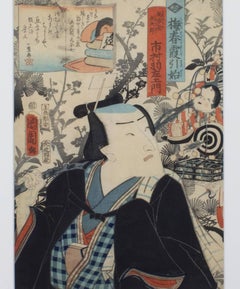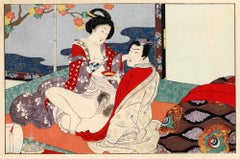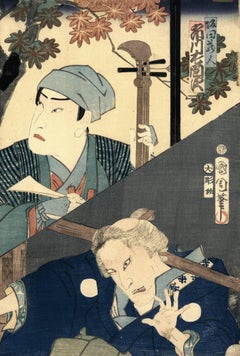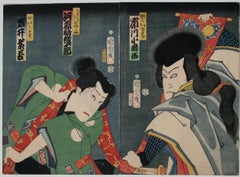Toyoharu Kunichika Figurative Prints
to
1
Overall Width
to
Overall Height
to
1
859
382
378
308
1
1
1
1
1
1
1
1
Artist: Toyoharu Kunichika
19th century color woodcut Japanese ukiyo-e print samurai figure
By Toyoharu Kunichika
Located in Milwaukee, WI
"Ichimura Hazaemon as Hatsuyumeya Mitsujiro" is a woodcut print by Toyoharu Kunichika in red, blue, and black.
14" x 9 1/2" art
20 3/4" x 16 3/4" framed
From the series “First Per...
Category
1860s Edo Toyoharu Kunichika Figurative Prints
Materials
Woodcut
Related Items
Japanese Beauties Enjoy a Full Moon
By Utagawa Kunisada (Toyokuni III)
Located in Burbank, CA
"Sun, Moon and Stars". Three beauties enjoy a full moon on the veranda of a teahouse or restuarant. The woman on the left kneels and adjusts her lavishly printed kimono. The beauty in the center has her hair down, and behind her is a screen against which shadows are beautifully silhouetted, which adds an air of mystery. The seated woman on the right is perhaps a geisha, as we see a shamisen lying next to her. Before her is a tray with an assortment of foods. One may surmise that the beauties are being compared to the sun, the moon, and the stars. On the left we glimpse a full moon shining over the peaceful bay, and boats at harbor. Original first edition Japanese color woodblock print triptych...
Category
1840s Edo Toyoharu Kunichika Figurative Prints
Materials
Mulberry Paper, Woodcut
$3,600
H 14.18 in W 29.06 in
Seishi Ai-oi Genji – Set of 12 Shunga works together w/astrological commentary
By Utagawa Kunisada (Toyokuni III)
Located in Middletown, NY
Set of 12 woodblock prints in colors on handmade, laid mulberry paper, 6 3/4 x 10 1/4 inches (170 x 258 mm), printed in Ka-ei 4 (1851). Each print with minor handling wear, otherwise in excellent condition with bright and fresh color, and with details printed in silver ink. The images themselves contain several illusive characters indicating the publisher which are obfuscated by figures, as intended. Presented loose, as issued. A fine set.
The astrological commentary print has a large and meandering blind stamp with a bird and palm frond motif. This print lists various phrases concerning the Twelve Zodiac Animals as historically counted in Japan, and appears to include erotic commentary on the traits of people born under each of the twelve signs.
These Shunga images were issued in books that paralleled (in an erotic fashion...
Category
Mid-19th Century Edo Toyoharu Kunichika Figurative Prints
Materials
Handmade Paper, Ink, Woodcut
Black Horse
By Tokuriki Tomikichiro
Located in Middletown, NY
circa 1950.
Woodblock print in black and gray ink on Japon laid paper, 10 1/4 x 15 3/4 inches (260 x 398 mm), full margins. With the artist's embossed chop mark in red ink in the l...
Category
Mid-20th Century Edo Toyoharu Kunichika Figurative Prints
Materials
Handmade Paper, Woodcut
Japanese Original Woodblock Print
Located in Soquel, CA
Japanese Original Woodblock Print
Harunobu Suzuki (né Hozumi) (Japanese, 1724 - 1770)
Presented in a black mat.
Mat: 16"H x 12"W
Paper: 12"H x 9"W
I...
Category
18th Century Edo Toyoharu Kunichika Figurative Prints
Materials
Ink, Rice Paper, Woodcut
The Lonely House at Asajigahara.
Located in Middletown, NY
A scene from a series of ghost stories and spooky rural legends.
Tokyo: Matsuki Heikichi, 1896.
Woodcut in ink with embossing and hand-coloring in watercolor on handmade mulberry pa...
Category
Late 19th Century Edo Toyoharu Kunichika Figurative Prints
Materials
Watercolor, Handmade Paper, Woodcut
Elegant Amusements of Eastern Genji - Japanese Triptych Woodblock Print on Paper
By Utagawa Kunisada (Toyokuni III)
Located in Soquel, CA
Elegant Amusements of Eastern Genji - Japanese Triptych Woodblock Print on Paper
Dynamic woodblock print with several elegantly dressed figures by Utag...
Category
1850s Edo Toyoharu Kunichika Figurative Prints
Materials
Paper, Ink, Woodcut
$1,550
H 22.5 in W 32.5 in D 1 in
Two Kabuki Actors Japanese Woodblock Print
By Toyohara Kunichika
Located in Houston, TX
Two kabuki actors posing a samurai's. The print is printed on rice paper and is not framed. It is stamped by the artist with details about the actors in ...
Category
1860s Edo Toyoharu Kunichika Figurative Prints
Materials
Woodcut
Edo Landscape Japanese Woodblock Print
By Utagawa Hiroshige (Ando Hiroshige)
Located in Houston, TX
Edo Meisho woodblock print of a famous Japanese coastal dock. This woodblock is most likely apart of the series "One Hundred Famous Views of Edo." The woodblock print is printed on r...
Category
1850s Edo Toyoharu Kunichika Figurative Prints
Materials
Woodcut
$1,500
H 10 in W 15 in D 0.004 in
Plucking a Branch from a Neighbor's Plum Tree
By Suzuki (Hozumi) Harunobu
Located in Middletown, NY
A mischievous tableau with sexual overtones.
Tokyo: Shuei-Sha, 1768.
Woodblock print in colors printed on laid mulberry paper, 10 3/4 x 7 7/8 inches (273 x 200 mm), full margins. I...
Category
Mid-18th Century Edo Toyoharu Kunichika Figurative Prints
Materials
Handmade Paper, Watercolor, Woodcut
$1,000
H 10.75 in W 7.88 in
The Battle of Dan-no-ura in Yashima, Nagato Province in the First Year .....
By Utagawa Yoshitora
Located in Middletown, NY
The Battle of Dan-no-ura in Yashima, Nagato Province in the First Year of the Bunji Era (1185)
Tokyo c. 1830
Woodblock print (nishiki-e) with ink and hand-coloring in watercolor on handmade mulberry paper, 14 7/16 x 9 15/16 inches (367 x 252 mm), ōban tate-e, the full sheet. In good condition with some handling creases. Colors are fresh and extremely vibrant. The right panel from the triptych by Yoshitora depicting one of Japan's most storied naval battles. An impression of this work may be found in the permanent collection of the Honolulu Museum of Art.
The great naval battle of Dan-no-ura in 1185 was the final climax in a long series of bitter wars between two powerful families in feudal Japan...
Category
Early 19th Century Edo Toyoharu Kunichika Figurative Prints
Materials
Watercolor, Handmade Paper, Woodcut
$1,500
H 14.44 in W 9.94 in
Actor Iwai Shigaku as Somenoi in "Denka chaya adauchi"
By Kuniyoshi
Located in Middletown, NY
Actor Iwai Shigaku as Somenoi in "Denka chaya adauchi" (Revenge at the Denka Teahouse), by Shigeharu, Ryusai (also called Kuniyoshi)
Tokyo: Horie Ichiba Wataki, 1835.
Woodcut on la...
Category
Early 19th Century Edo Toyoharu Kunichika Figurative Prints
Materials
Laid Paper, Handmade Paper, Woodcut
Toshogu Shrine
Located in Middletown, NY
In image of the Tokugawa family paying homage to Tosho-gu Shrine in Nikko.
Tokyo: Matsuki Heikichi, 1896
Woodcut in ink with embossing and hand-coloring in watercolor on handmade m...
Category
Late 19th Century Edo Toyoharu Kunichika Figurative Prints
Materials
Watercolor, Handmade Paper, Woodcut
Previously Available Items
Kabuki Actors: Ichikawa and Iwai.
By Toyoharu Kunichika
Located in Storrs, CT
14 x 9 1/2 (sheet 14 x 3/4). Good color and condition. Soiling in the bottom right-hand; slight toning. Signed and sealed 'Kunichika hitsu'.
Housed in a 20 x 16 inch archival mat, suitable for framng.
Born in 1835, Toyohara Kunichika grew up in the Kyobashi district of Edo in the midst of merchants and artisans. In 1848, at age 13, he was accepted as an apprentice into the studio of Utagawa Kunisada I...
Category
Mid-19th Century Edo Toyoharu Kunichika Figurative Prints
Materials
Color, Woodcut
Kabuki Actors Iwai and Ichikawa
By Toyoharu Kunichika
Located in Storrs, CT
Kabuki Actors Iwai and Ichikawa 1864. Oban diptych (14 1/8 x 19 1/4. Good color and condition. The print is not laid down. The sheets are not joined tog...
Category
Mid-19th Century Edo Toyoharu Kunichika Figurative Prints
Materials
Color, Woodcut
Toyoharu Kunichika figurative prints for sale on 1stDibs.
Find a wide variety of authentic Toyoharu Kunichika figurative prints available for sale on 1stDibs. You can also browse by medium to find art by Toyoharu Kunichika in woodcut print and more. Not every interior allows for large Toyoharu Kunichika figurative prints, so small editions measuring 17 inches across are available. Customers who are interested in this artist might also find the work of Utagawa Hiroshige (Ando Hiroshige), Kunichika Toyohara, and Toyohara Kunichika. Toyoharu Kunichika figurative prints prices can differ depending upon medium, time period and other attributes. On 1stDibs, the price for these items starts at $3,000 and tops out at $3,000, while the average work can sell for $3,000.




